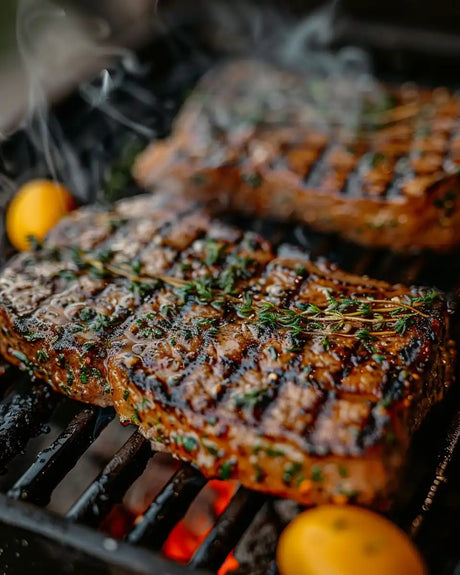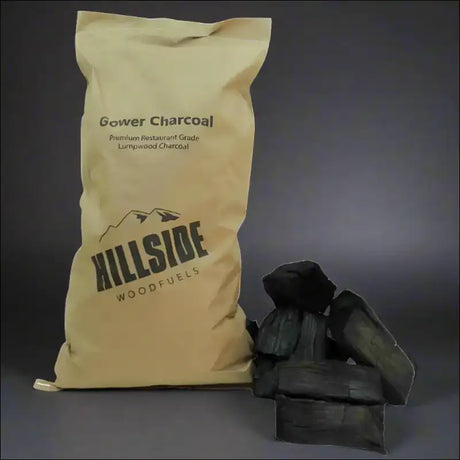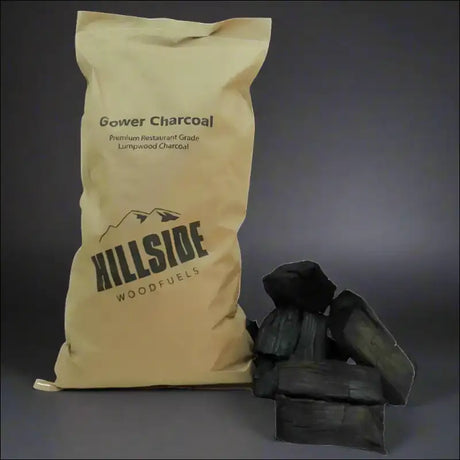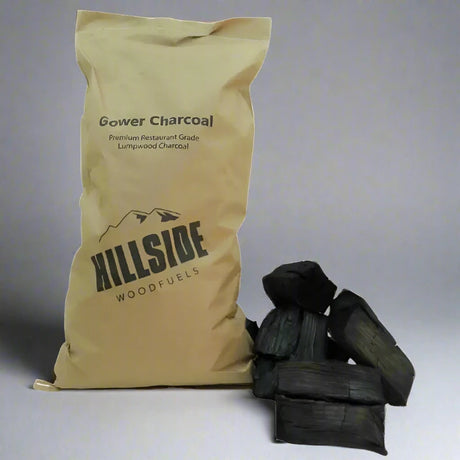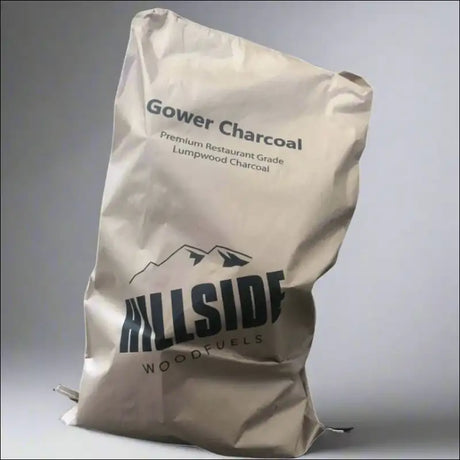Lumpwood charcoal is gaining popularity among Pitmasters for its natural composition and superior grilling qualities compared to briquettes. Made from real hardwood and burned in a low-oxygen environment, lumpwood charcoal is a purer form of carbon, free from fillers and additives. It offers a higher heat output, quick ignition, and enhances the flavor and aroma of grilled foods. Understanding the nuances of lumpwood charcoal, from its environmental impact to its practical applications, can elevate the grilling experience.
Key Takeaways
- Lumpwood charcoal is preferred for its natural, additive-free composition and ability to produce a higher heat output than briquettes.
- It ignites quicker than other grilling fuels, making it a convenient choice for Pitmasters seeking efficiency.
- The quality of lumpwood charcoal is evident in its clean burn, minimal ash production, and lack of sparking.
- Different wood types used in lumpwood charcoal can impart unique flavors and aromas, enhancing the culinary experience.
- Ethical sourcing and sustainability are important considerations when selecting lumpwood charcoal, reflecting a growing environmental consciousness among consumers.
Understanding Lumpwood Charcoal

The Basics of Lumpwood Charcoal
When we talk about lumpwood charcoal, we're referring to the purest form of charcoal used in grilling. It's created by burning hardwood in a low-oxygen environment, a process that carbonizes the wood and turns it into the lump charcoal we use for cooking. Unlike briquettes, lumpwood charcoal is free from binders, fillers, and additives, making it a preferred choice for many of us who are passionate about the quality and purity of our grilling ingredients.
Quality is paramount when it comes to lumpwood charcoal, and it's evident in its irregular shapes and sizes. This is a direct result of using natural wood, which also contributes to the more authentic flavor it imparts to food. Here's a quick list of what sets lumpwood apart from other types of charcoal:
- Higher carbon content for a hotter burn
- Quicker ignition time
- Minimal chemical additives
- More pronounced wood-fired flavor
Remember, the choice of charcoal can significantly influence the taste and overall grilling experience. Lumpwood charcoal, with its natural composition, offers a distinct advantage in this regard.
Comparing Lumpwood to Briquettes
When we delve into the world of outdoor cooking, the choice between lumpwood charcoal and briquettes is a pivotal one. Lumpwood charcoal is the purist's choice, often heralded for its ability to provide a high heat output and a more authentic grilling experience. On the other hand, briquettes are known for their uniform shape, consistent burn time, and ease of use.
Heat output is a significant factor in this comparison. Our tests with a surface temperature thermometer revealed that lumpwood charcoal indeed generates more heat than briquettes. However, it's important to note that while lumpwood burns hotter, it does not last as long as briquettes, which could influence your decision based on the cooking duration.
The nature of the starting wood in lumpwood charcoal greatly influences its burning characteristics and the flavors it imparts on the food.
Here's a quick rundown of the key differences:
- Lumpwood charcoal is made from real hardwood and contains no fillers.
- Briquettes are machine-made and often contain wood fillers and binders.
- Lumpwood ignites quicker and burns hotter.
- Briquettes offer a more controlled and longer-lasting burn.
Choosing between the two often comes down to personal preference and the specific needs of your barbecue session. Whether you're in Mumbles or South Wales, sourcing premium lump charcoal tailored for grilling and smoking can elevate your outdoor cooking experience.
Environmental Considerations
When we consider the environmental impact of our grilling choices, lumpwood charcoal stands out for its natural composition and cleaner burn. Unlike briquettes, which often contain additives and binders, lumpwood charcoal is made from pure charred wood, offering better airflow and burn. This results in a more efficient and environmentally friendly grilling experience.
Sustainable sourcing and clean burning are key to minimizing the ecological footprint of our barbecues. We prioritize lumpwood charcoal that boasts a high carbon content and low moisture levels, ensuring a hotter and longer-lasting fire. The quality of lumpwood charcoal is determined by its size, density, moisture, and carbon content, which directly influence its environmental performance.
By choosing responsibly sourced lumpwood charcoal, we not only enhance our culinary endeavors but also contribute to a healthier planet.
Here are some considerations we keep in mind:
- The origin of the wood used for charcoal production
- The methods employed in harvesting and charring the wood
- The presence of any certifications indicating sustainable practices
The Advantages of Lumpwood Charcoal

Higher Heat Output
When we grill, the heat output of our charcoal is a critical factor in achieving the perfect sear and cooking temperature. Lumpwood charcoal is renowned for its superior heat output compared to briquettes, making it a preferred choice for those of us seeking that intense heat. The inconsistency in size and shape of lumpwood pieces can affect how they burn, but generally, they reach higher temperatures more quickly.
The ability to reach and maintain high temperatures is not just about the charcoal itself, but also about how we manage the airflow and the grill. Proper ventilation is key to maximizing the heat potential of lumpwood charcoal.
This is essential for long grilling sessions where consistent, high heat is necessary to deliver perfectly cooked meals. Gower Charcoal, for instance, offers pure wood lumpwood charcoal that not only provides better burn and natural flavors but also contributes to an eco-friendly grilling experience.
Quicker Ignition Time
We've all experienced the anticipation of grilling, where every minute waiting for the charcoal to ignite feels like an eternity. Lumpwood charcoal's quicker ignition time is a game-changer, offering us the ability to start cooking sooner. Unlike briquettes, lumpwood charcoal is more responsive to oxygen, which means it catches fire more readily and reaches cooking temperatures rapidly.
- Using a heated air blower
- Electric starter, such as a Looftlighter
These methods enhance the natural quick-ignition properties of lumpwood, making it a preferred choice for those impromptu barbecue sessions. It's not just about saving time; it's about the ease and convenience that comes with a hassle-free start to our grilling adventures.
With lumpwood charcoal, we're not just firing up the grill; we're igniting the promise of a great meal with less waiting and more savoring.
Natural and Additive-Free
We often seek out the purest forms of cooking ingredients to ensure the integrity of our dishes. Lumpwood charcoal stands out as it is completely natural and free from additives. This means that when we choose lumpwood, we're not only opting for a superior fuel but also one that won't impart any unwanted chemicals or flavors into our food.
The absence of additives in lumpwood charcoal makes it a prime choice for those of us who prioritize health and the authentic taste of grilled food. Unlike briquettes, which may contain binders and fillers, lumpwood charcoal is made from hardwood without any additional substances. It's the simplicity of lumpwood that appeals to purists and health-conscious grillers alike.
When we use lumpwood charcoal, we're embracing a tradition of purity in our grilling practice. It's a commitment to cooking that respects both the ingredients and the environment.
For those in commercial settings, such as restaurants, the choice often falls on restaurant grade lump charcoal. It's not just about the health benefits or the clean taste—it's also about performance. Restaurant grade lump charcoal is ideal for commercial settings, offering higher heat output, longer burning time, less ash, consistency, purity, and versatility for grilling and barbecuing.
Selecting the Best Lumpwood Charcoal

Characteristics of High-Quality Lumpwood
When we're on the hunt for premium lump charcoal, especially for grilling enthusiasts like those in Loughr, South Wales, we look for certain characteristics that set high-quality options apart. Size and consistency are crucial; we prefer charcoal chunks that are well-sized, akin to a hardball, as they tend to burn longer and hotter. Small, potato chip-sized pieces often indicate a lower quality and reduced heat output.
The best lump charcoal is derived from natural hardwood and is free of binders, fillers, or chemicals. This ensures that the charcoal ignites immediately and burns for an extended period, producing minimal ash. Moreover, the absence of sparking is a sign of superior quality, as it indicates the use of denser, slower-burning woods.
It's also essential to consider the environmental impact of our choices. Opting for charcoal made with sustainable practices reflects our commitment to responsible grilling.
Finally, understanding the wood types and their respective flavors can enhance our culinary experience. Different hardwoods impart distinct aromas and tastes, which can be tailored to the specific dishes we're preparing.
Understanding Wood Types and Flavors
When we delve into the world of lumpwood charcoal, we quickly realize the profound impact that the originating wood species has on our culinary experience. Different woods impart unique flavors and aromas, making the choice of lumpwood charcoal a crucial aspect of grilling.
For instance, oak charcoal is a staple in the grilling community, known for its intense and slightly bitter taste that enhances the umami flavors in meats. It's a safe bet for those new to charcoal grilling. On the other hand, cherry wood offers a sweet and mild profile, ideal for fish, chicken, duck, and even vegetables.
- Oak – Intense, slightly bitter, great for meats
- Cherry – Sweet, mild, versatile for various proteins and vegetables
- Hickory – Strong, smoky, perfect for fatty meats
Tree mixes are also popular, combining different woods to create complex flavor profiles. It's an adventure for the palate, as these mixes can include a variety of hardwoods in different proportions. We encourage you to experiment with these to discover the intricate flavors they can bring to your dishes.
The nature of the starting wood not only influences the flavor but also the burn characteristics of the charcoal. Understanding this can significantly enhance your fire experience.
Sustainability and Ethical Sourcing
When we choose lumpwood charcoal, we're not just selecting a fuel for our grills; we're making a decision that impacts the environment and communities involved in its production. Sustainability and ethical sourcing are paramount in this process. We must consider the origins of the charcoal, the methods used to produce it, and the practices that support the well-being of ecosystems and local populations.
Ethical sourcing ensures that the charcoal we use does not contribute to deforestation or exploit labor. By opting for suppliers who prioritize the use of kiln-dried firewood logs, we can reduce air pollution, preserve biodiversity, and minimize deforestation. It's essential to follow best practices for storage and usage to achieve optimal results.
As responsible consumers, we have the power to influence the market by demanding sustainably sourced products. Our choices can lead to a positive ripple effect across the industry.
Here's a quick checklist to guide our purchasing decisions:
- Verify the source of the lumpwood charcoal.
- Look for certifications that indicate sustainable practices.
- Choose products that detail the type of wood used and its origin.
- Inquire about the production process and whether it minimizes environmental impact.
Cooking with Lumpwood Charcoal

Enhancing Flavor and Aroma
When we grill with lumpwood charcoal, we're not just cooking; we're infusing our food with subtle nuances of flavor that only natural wood can provide. The choice of wood type is crucial, as each imparts a distinct taste and aroma to the dish. For instance, cherry wood lends a sweet and mild flavor, perfect for fish, chicken, and duck, enhancing the overall dining experience.
- Oak – Ideal for robust meats, adding a strong smoky taste.
- Hickory – Imparts a bold, slightly bitter flavor, great for fatty cuts.
- Apple – Offers a milder, sweeter note, versatile for various meats.
Experimenting with different wood types allows us to tailor the flavor profile to our liking. It's not just about the heat; it's about the character the smoke adds to the meal. As we explore the impact of lumpwood charcoal on our dishes, we find that the right choice can elevate a simple barbecue to a gourmet feast.
The art of grilling is as much about the aroma as it is about the taste. The smoke from the charcoal weaves through the food, leaving behind a trail of complex flavors that can turn an ordinary meal into an extraordinary one.
Managing Heat and Burn Time
When we talk about the mastery of grilling with lumpwood charcoal, managing heat and burn time is crucial. We aim for a balance between maintaining a consistent temperature and extending the charcoal's burn time. Lumpwood charcoal is super easy to ignite and get going, which means we can reach cooking temperatures quickly. However, the burn time can vary significantly, often lasting between 1-3 hours depending on the type of hardwood used.
To optimize our grilling sessions, we consider the charcoal's burn time and heat output. For instance, Gower charcoal can maintain a 'High' temperature above 572F for over 2 hours and 40 minutes, with a substantial amount left for continued cooking. This is a testament to the efficiency of high-quality lumpwood charcoal.
Here's a quick comparison of burn times for different brands:
| Brand | Burn Time | Temperature |
|---|---|---|
| Gower Charcoal | >2h 40m | High (>572F) |
| Jealous Devil | >2h 40m | Moderate |
| Premium Brand | >2h 40m | High |
| Cowboy | 2h 40m | Low |
We always weigh the cost against the burn time and heat output. Paying a premium for charcoal that offers longer burn times and consistent high heat can lead to fuel savings and a better grilling experience overall.
Tips for Lighting and Maintaining a Charcoal Grill
When we're eager to start grilling, we often overlook the importance of properly lighting and maintaining our charcoal grill. Proper ignition is crucial for a consistent cooking temperature and to avoid unwanted flavors.
Firelighters or starters use paraffin wax, compressed cardboard, or wax coated wood shavings to ignite the charcoal. They are a reliable alternative to lighter fluid, which can leave an unpleasant taste in the food. Here's a quick list of steps for using a chimney starter:
- Fill the chimney with lumpwood charcoal.
- Place the firelighter or starter at the bottom.
- Light the firelighter and wait a few minutes.
- Once the charcoal is lit, pour it into the grill.
Maintaining the right temperature is a dance with oxygen. By controlling the air intake, we can achieve the perfect heat for our culinary creations, whether it's a quick sear or a low and slow cook.
Remember, patience is key. It may take some time for the entire pile of charcoal to heat up after being placed in the grill. Keep all vents open to ensure a good airflow and monitor the heat output regularly. If done correctly, you'll be rewarded with a grill that's ready for anything from reverse searing cowboy steaks to a leisurely barbecue.
Lumpwood Charcoal in Practice

Real-World Pitmaster Preferences
In our collective experience, we've observed a strong preference for lumpwood charcoal among pitmasters, especially when precision and high heat are required. The ability to reach searing temperatures quickly is crucial for creating that perfect crust on a steak or achieving the ideal char on vegetables.
Pitmasters often mention the minimal ash production of lumpwood charcoal as a significant advantage, which aligns with the common critique that briquettes produce more ash due to additives. This not only affects the flavor but also the ease of cleaning post-BBQ, allowing more time to socialize with guests.
While some may argue that 'Buy Whatever is Cheapest!' is a good rule of thumb, the nuances of lumpwood charcoal's performance cannot be overstated.
Here's a quick rundown of pitmaster observations:
- Searing capabilities: Lumpwood excels in delivering juicy yet charred results.
- Consistency: Despite some uneven browning, the overall cooking experience is positive.
- Aesthetics: The natural look of lumpwood charcoal adds to the BBQ's appeal.
- Heat management: Requires practice but offers superior control once mastered.
Case Studies: Lumpwood vs. Briquettes
In our quest to understand the practical differences between lumpwood charcoal and briquettes, we've conducted a series of case studies. We found that lumpwood charcoal indeed has a higher heat output, a fact that aligns with the experiences of many pitmasters. This was quantified using a surface temperature thermometer, revealing that lumpwood charcoal consistently reached higher temperatures than briquettes.
However, it's not just about the heat. The burn time of charcoal is crucial for cooking sessions. Our tests showed that while lumpwood charcoal burns hotter, briquettes tend to have a longer burn time. This is an important consideration for those long, slow cooks where maintaining a consistent temperature is key.
The choice between lumpwood and briquettes often comes down to the specific needs of the cook. Whether it's the intense heat for searing steaks or the prolonged burn for smoking brisket, each type of charcoal has its place.
Here's a summary of our findings:
- Lumpwood Charcoal: Higher heat, quicker ignition, natural composition
- Briquettes: Longer burn time, consistent shape, often contain additives
These insights help us appreciate the socioeconomic and environmental benefits of choosing the right type of charcoal for our needs. Notably, charcoal briquettes, while denser and with a higher calorific power, may not always be the preferred choice for those seeking a pure and intense grilling experience.
Expert Tips for Lumpwood Charcoal Use
When we talk about using lumpwood charcoal, we're discussing a craft as much as a cooking method. Always inspect the charcoal before use; avoid bags with excessive dust or foreign objects. This ensures a clean, uncontaminated burn, crucial for the perfect grilling experience.
To light lumpwood charcoal, steer clear of lighter fluids. Instead, opt for natural fire starters to maintain the purity of flavor in your food. Here's a simple list to get your charcoal glowing:
- Use a chimney starter with some newspaper
- Employ an electric charcoal starter
- Try natural firelighter cubes
Remember, the goal is to achieve a fire that's both hot and healthy for cooking. Once lit, controlling the airflow in your grill is key to managing the temperature. Want a searing hot flame? Increase the airflow. For a low and slow cook, just dial it back. This control is what makes lumpwood charcoal a favorite among pitmasters.
Premium lump charcoal is not just about heat; it's about enhancing the flavor profile of your grilled foods. By choosing high-quality charcoal, like those available for local delivery in Bishopston, you elevate not just the temperature but the entire grilling game.
Conclusion
In conclusion, lumpwood charcoal stands out as the preferred choice for many Pitmasters due to its natural composition, higher heat output, and quick lighting properties. Made from real hardwood and devoid of fillers or additives, lump charcoal offers a purer, more intense heat that enhances the flavor and aroma of grilled foods. While it may be more expensive and have a shorter burn time compared to briquettes, the quality of the cooking experience and the environmental considerations make it a worthwhile investment for those passionate about grilling. As we've explored the best lump charcoal options and their unique properties, it's clear that understanding the nuances of this grilling essential can significantly impact the results of your barbecue endeavors.
Frequently Asked Questions
What exactly is lumpwood charcoal?
Lumpwood charcoal is real hardwood that has been burned in a low-oxygen environment to turn the wood into a natural, carbon-rich fuel without fillers or additives.
Why do Pitmasters prefer lumpwood charcoal over briquettes?
Pitmasters prefer lumpwood charcoal because it provides a higher heat output, quicker ignition time, and is natural and additive-free, resulting in cleaner, more flavorful cooking.
How does lumpwood charcoal compare to briquettes in terms of environmental impact?
Lumpwood charcoal is considered more environmentally friendly as it typically contains no fillers or chemicals and is made from natural hardwood, whereas briquettes may contain various additives and binders.
What characteristics define high-quality lumpwood charcoal?
High-quality lumpwood charcoal is made from natural hardwood, burns cleanly with little ash, ignites quickly, offers a long burn time, and has evenly sized, large pieces without sparking.
How does the type of wood used in lumpwood charcoal affect flavor?
The starting wood type in lumpwood charcoal determines its flavor and burning characteristics, with different hardwoods imparting distinct aromas and tastes to the food.
What are some tips for lighting and maintaining a charcoal grill with lumpwood charcoal?
To light a charcoal grill with lumpwood charcoal, create a pile for concentrated heat, use a chimney starter for quick ignition, and adjust air vents to control temperature and maintain consistent heat.


